Your cooking area should be more than just a place to prepare meals. It can be a peaceful retreat where you find joy in everyday tasks. Many people now seek designs that blend simplicity with warmth, making their space feel inviting.
Minimalist layouts, natural textures, and smart storage help create a soothing atmosphere. The right balance of light and open space can turn meal prep into a relaxing ritual. This approach combines beauty with practicality.
More homeowners want rooms that serve as emotional hubs. Thoughtful design choices make daily routines feel intentional. A well-planned setup promotes both efficiency and tranquility.
Key Takeaways
- Modern cooking spaces should balance function and relaxation
- Natural materials and clean lines enhance a soothing vibe
- Smart storage keeps surfaces clutter-free
- Lighting plays a crucial role in setting the mood
- Simple layouts create easier movement and flow
1. Introduction to Zen Kitchen Design
More than just functional, kitchens shape our emotional connection to home. A 2024 NAR survey found 87% of homeowners prioritize calm environments here. Zen principles—simplicity, mindfulness, and nature—answer this need.
The Heart of the Home: Why Zen Matters
Cluttered counters and chaotic layouts add stress. A Zen kitchen minimizes distractions, letting you focus on cooking’s joy. “The space around objects is as important as the objects themselves,” reflects Marie Kondo’s influence.
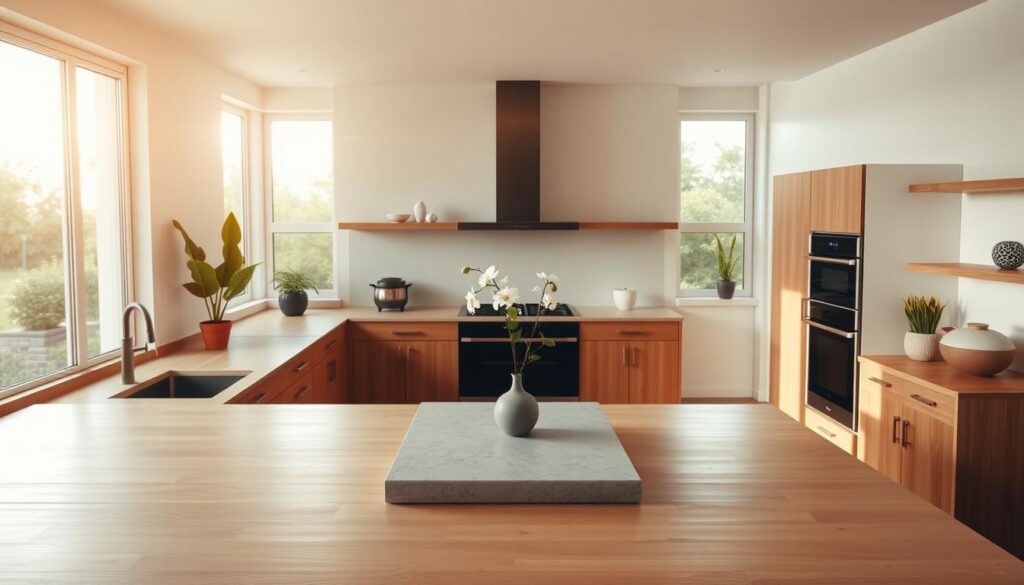
- Improved focus from fewer visual distractions
- Faster cleaning with intentional storage
- Deeper family connections in a peaceful setting
Core Principles of Zen Aesthetics
Japanese “Ma”—negative space—ensures breathing room in layouts. Key elements include:
- Natural materials like wood and stone
- Neutral palettes for visual calm
- Hidden storage to maintain clean lines
68% of renovators now seek “calm kitchens,” proving this trend’s longevity. By blending function and serenity, kitchen design becomes a daily retreat.
2. Embracing Minimalism for a Clutter-Free Space
Decluttering isn’t just about space—it’s about peace of mind. A minimalist approach aligns with zen principles, turning chaos into calm. Start by evaluating what truly belongs in your cooking zone.
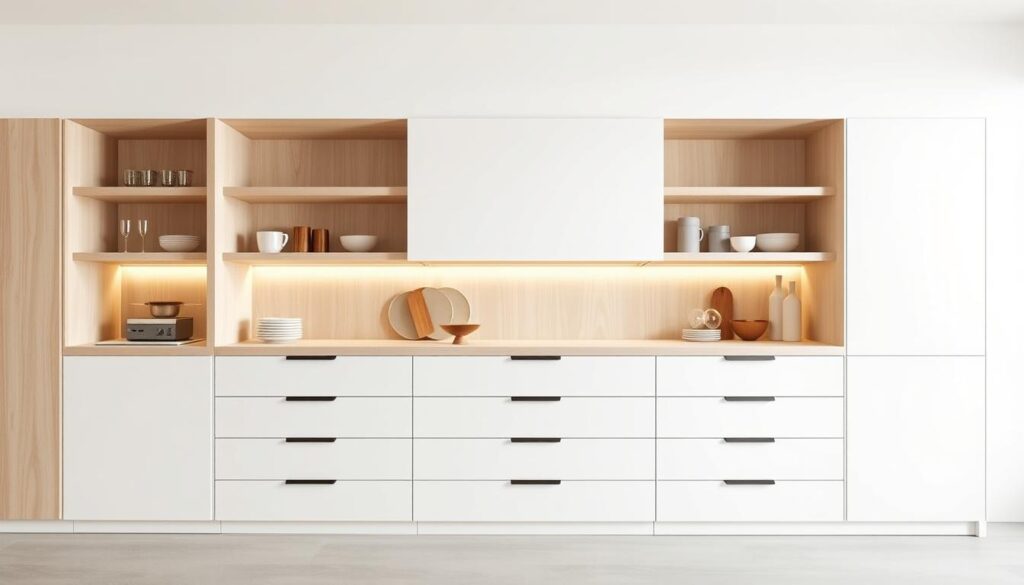
The KonMari Method for Kitchen Decluttering
Marie Kondo’s famous method cuts kitchen items by 40% on average. Hold each tool and ask: “Does this spark joy?” If not, thank it and let it go. This creates room for what matters.
- Step-by-step joy-check: Sort utensils, appliances, and pantry goods in one session.
- Hidden costs: Clutter leads to $1,200/year in duplicate buys (National Association of Professional Organizers).
- Cabinet makeover: Use dividers to group like items—before/after photos show dramatic results.
Essential Items vs. Excess
Adopt the “one in, two out” rule for appliances. For every new purchase, remove two unused gadgets. Vertical storage solutions, like Blum’s Space Tower, boost space by 22%.
“Minimalism is the intentional promotion of what we value most.” — Joshua Becker
Keep countertops clear with these priorities:
- Daily-use tools (knives, cutting boards)
- High-quality appliances (blender, toaster)
- Multifunctional cookware (Dutch oven, skillet)
3. Neutral Color Palettes for Calmness
Colors shape how we feel in a space, especially where meals come to life. Sherwin-Williams reports a 63% surge in demand for warm whites like “Alabaster” in 2024. These neutral colors foster focus, making prep work feel effortless.
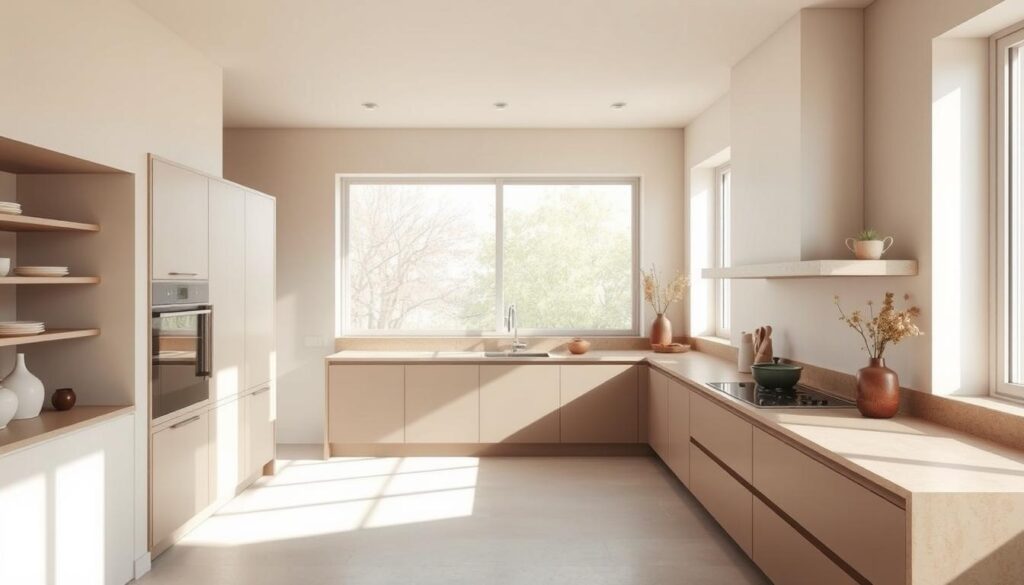
Best Colors for Serenity
Whites, beiges, and soft grays form the core of a soothing color palette. Farrow & Ball’s “Skimming Stone” offers a versatile warm gray with earthy tones. For ceilings, matte finishes diffuse light gently, while eggshell resists smudges.
| Finish | Best For | Light Effect |
|---|---|---|
| Matte | Ceilings, low-traffic walls | Soft, glare-free |
| Eggshell | Backsplashes, cabinets | Slight sheen, durable |
Accent Colors to Enhance Serenity
Johns Hopkins research shows blue accents lower stress by 18%. Pantone’s 2024 “Tranquil Dawn”—a muted teal—pairs perfectly with stone counters. Use these sparingly on a single wall or open shelving for balance.
Cool undertones make compact kitchens feel airy, while warm hues add coziness. A zen-inspired kitchen thrives on this careful mix, creating a sense of harmony with every glance.
4. Natural Materials to Connect with Nature
Bringing the outdoors inside creates a calming kitchen atmosphere. Wood, stone, and bamboo introduce organic textures that soothe the senses. These materials blend durability with timeless appeal.
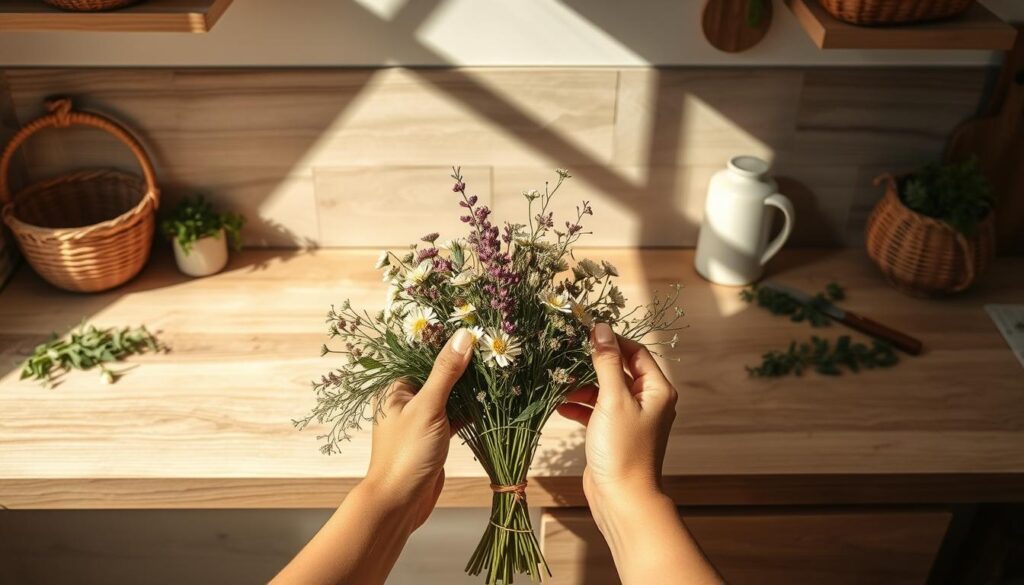
Wooden Countertops and Bamboo Shelving
Teak offers superior water resistance, while reclaimed pine adds rustic charm. Bamboo grows 30x faster than oak, making it an eco-friendly choice for shelves and cutting boards.
Consider these elements when selecting wood:
- Teak: Dense grain resists scratches (lasts 25+ years)
- Bamboo: Harder than maple when properly sealed
- Reclaimed pineBudget-friendly but requires yearly oiling
Stone Backsplashes and Flooring
Soapstone naturally resists bacteria 97% better than laminate surfaces. Fireclay’s recycled glass tiles offer colorful nature-inspired patterns without sacrificing durability.
Compare popular stone options:
| Material | Cost/sq.ft | Maintenance |
|---|---|---|
| Slate | $8-$20 | Annual sealing |
| Quartzite | $60-$100 | Wipe-only |
| Basalt (Native Trails) | $45-$75 | Minimal care |
“Natural stone develops character over time—each scratch tells your kitchen’s story.” — Marble Institute of America
For porous materials like limestone, use penetrating sealers every 2 years. This preserves both beauty and hygiene in high-use areas like countertops.
5. Clean Lines and Functional Layouts
Smart layouts transform meal prep into a seamless experience. The right combination of clean lines and intelligent spacing creates both beauty and efficiency. This approach turns everyday cooking into a pleasure rather than a chore.
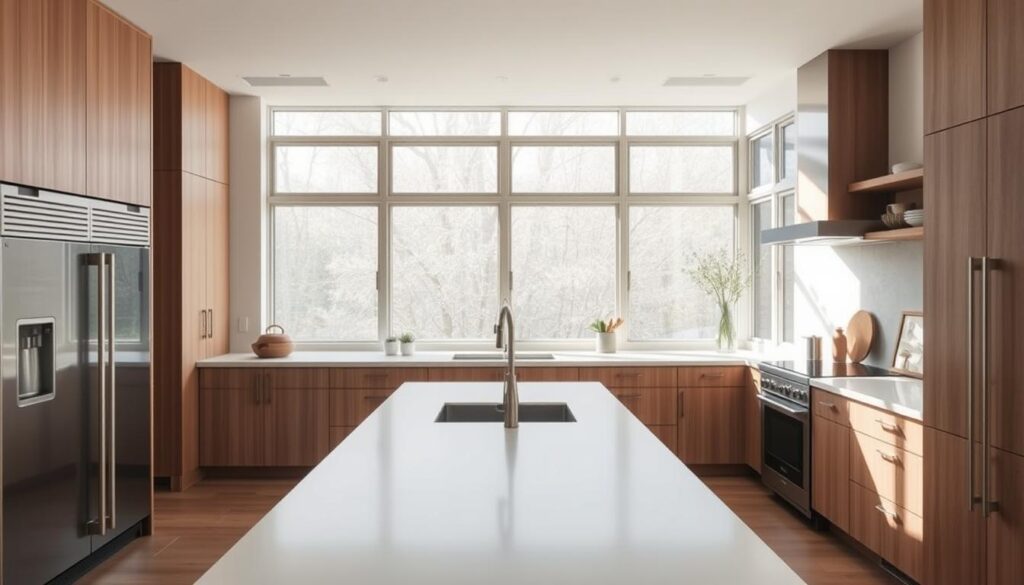
The Work Triangle: Sink, Stove, and Refrigerator
Professional designers swear by the work triangle concept. The ideal perimeter between these three points measures 12-26 feet for optimal functionality. This golden rule minimizes unnecessary steps during food preparation.
Consider these layout comparisons:
- Galley kitchens: Perfect for narrow spaces with parallel counters (20% more efficient workflow)
- L-shaped designs: Offer corner flexibility with 15% more prep space
- U-shaped layouts: Provide maximum storage but require 10+ sq.ft extra
Flat-Front Cabinetry and Sleek Hardware
Handleless cabinet design isn’t just trendy—it’s practical. Studies show it reduces cleaning time by 33% compared to traditional knobs. Modern mechanisms like Häfele’s push-open systems create flawless surfaces.
Popular cabinet profiles compared:
| Style | Best For | Maintenance |
|---|---|---|
| Slab | Contemporary spaces | Wipe-clean only |
| Shaker | Transitional decor | Grooves need occasional dusting |
| Inset | Traditional homes | Requires precise alignment |
“The best hardware disappears into the design while enhancing daily use.” — Buster + Punch design team
For left-handed cooks, position the dishwasher to the right of the sink. Right-handed users prefer appliances arranged counter-clockwise. These small adjustments make big differences in workflow comfort.
6. Maximizing Storage with Zen Principles
Smart storage transforms chaos into harmony, making every item easy to find. When everything has its place, cooking becomes more enjoyable. The right storage solutions maintain clean lines while keeping essentials within reach.
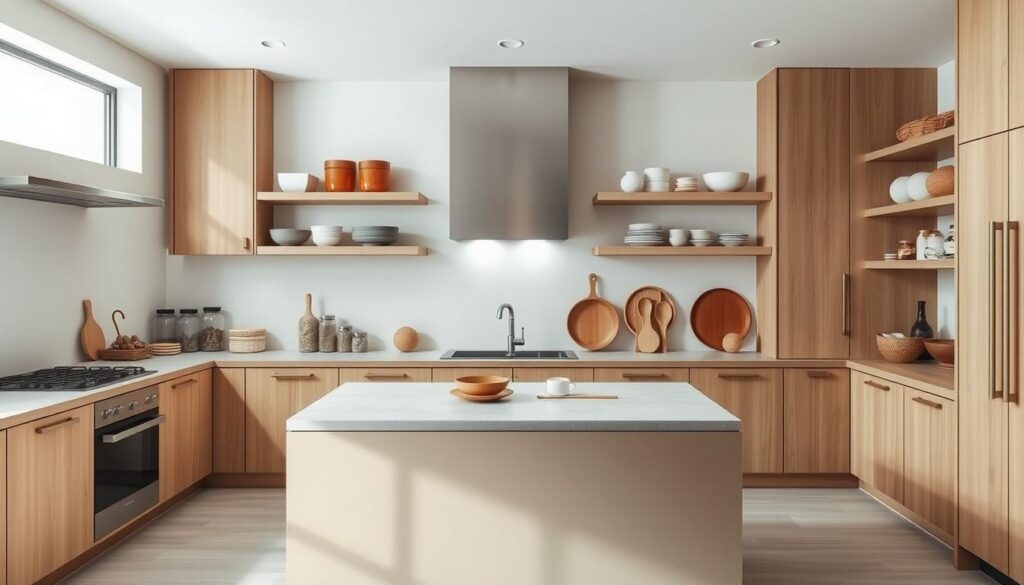
Hidden Cabinets and Drawer Organizers
Rev-A-Shelf’s pull-out systems increase cabinet accessibility by 70%. Their 300% rack system creates triple-tier storage for spices and canned goods. Custom laser-measured dividers keep baking sheets upright and organized.
Consider these innovative options:
- Rotating corner units (CabinetCorp): Utilizes “dead space” with 180° turns
- IKEA VARIERA inserts: Affordable drawer dividers with modular configurations
- Soft-close mechanisms: Reduce noise by 40 decibels compared to standard drawers
Vertical Storage Solutions
Walls offer untapped potential for space optimization. A well-planned vertical system can store 3x more than traditional cabinets.
| System | Best For | Capacity Increase |
|---|---|---|
| Pegboard | Utensils & pans | 15-20 items/sq.ft |
| Rail with hooks | Heavy cookware | Up to 50 lbs/rail |
| Magnetic strips | Knives & spices | 100% wall utilization |
“Good design is as little design as possible—especially when it comes to storage.” — Dieter Rams
These zen principles of simplicity apply perfectly to cabinets and shelves. By combining smart technology with minimalist aesthetics, your storage becomes both beautiful and highly functional.
7. Zen House Aesthetic Kitchen Ideas for Small Spaces
Compact cooking spaces demand smart solutions that blend form and function. With 68% of urban homes under 1,500 sq.ft, every inch counts. The right approach creates both visual openness and practical workflow.
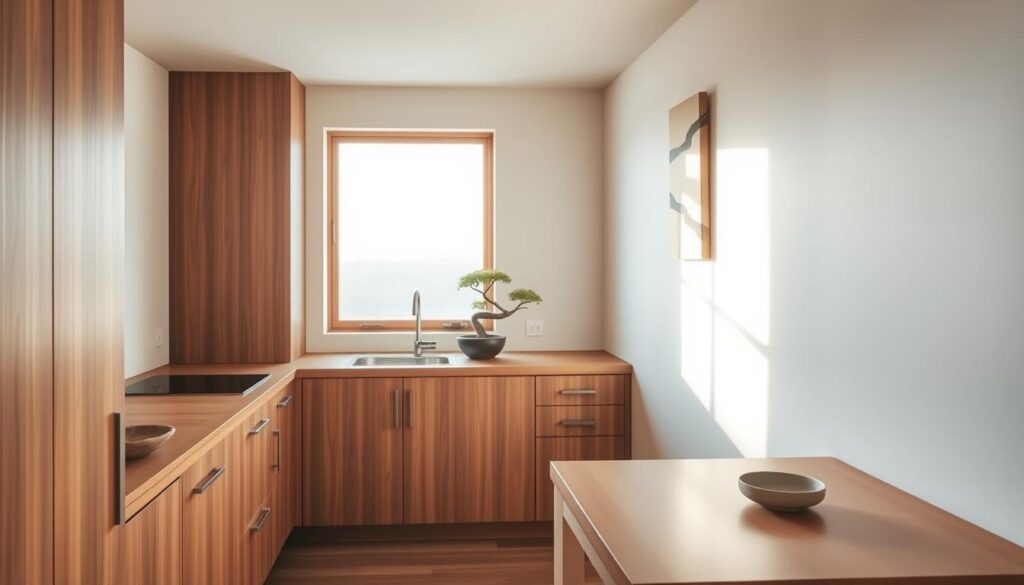
Floating Shelves and Open Storage
Glass shelves reflect light, making walls appear 15% farther apart. Live edge wood adds organic warmth while maintaining clean sightlines. Consider these material comparisons:
- Glass: Maximizes light reflection but shows dust
- Reclaimed wood: Adds texture but requires sealing
- Powder-coated metal: Ultra-slim profile for tight spots
Magnetic strips save drawer space by holding knives and spice jars. Position them near prep zones for quick access during cooking.
Space-Saving Islands That Multitask
Resource Furniture’s transforming models include pop-up outlets and hidden stools. Always maintain 36″ clearance around islands for comfortable movement.
Smart small-space features to consider:
- 18″ dishwashers that fit narrow gaps
- Slim refrigerators with French doors
- Fold-down breakfast bars with integrated lighting
“In small kitchens, every element must earn its place through daily usefulness.” — Sarah Susanka, Not So Big House
These design strategies prove limited square footage can still deliver functionality and style. By choosing multi-purpose elements, even tiny areas become enjoyable to use.
8. Lighting for a Peaceful Ambiance
The right lighting transforms meal prep into a calming ritual. It balances function and mood, turning tasks into moments of tranquility. Studies show 5000K LEDs boost task performance by 24%, proving light impacts more than visibility.

Natural Light Maximization
Sheer linen curtains diffuse sunlight beautifully, reducing glare by 40%. For south-facing windows, UV-filtering films protect surfaces while maintaining brightness. Compare treatments:
- Roman shades: Adjustable light control, 70% diffusion
- Frosted glass: Privacy with 85% light transmission
- Bamboo blinds: Organic texture, 50% sunlight filtration
Dimmable and Layered Lighting
Ketra’s circadian systems adapt to natural rhythms, easing eye strain by 41%. Combine three layers for a zen-inspired kitchen:
- Task lighting: Under-cabinet LED strips (300 lumens/ft)
- Ambient glow: Artemide Nichibei pendants (30″ above islands)
- Accent spots: Directional gimbals for artwork or plants
“Lighting should whisper, not shout—guiding movement without distraction.” — Hervé Descottes, L’Observatoire International
This approach crafts an atmosphere where every switch enhances the sense of calm. From dawn to dusk, your space feels harmoniously illuminated.
9. Incorporating Mindfulness into Your Kitchen
Transforming meal prep into a mindful practice enhances both food and well-being. A 2024 UCLA study found 15 minutes of intentional cooking lowers cortisol levels by 27%. Simple design tweaks can turn your space into a sanctuary for presence.
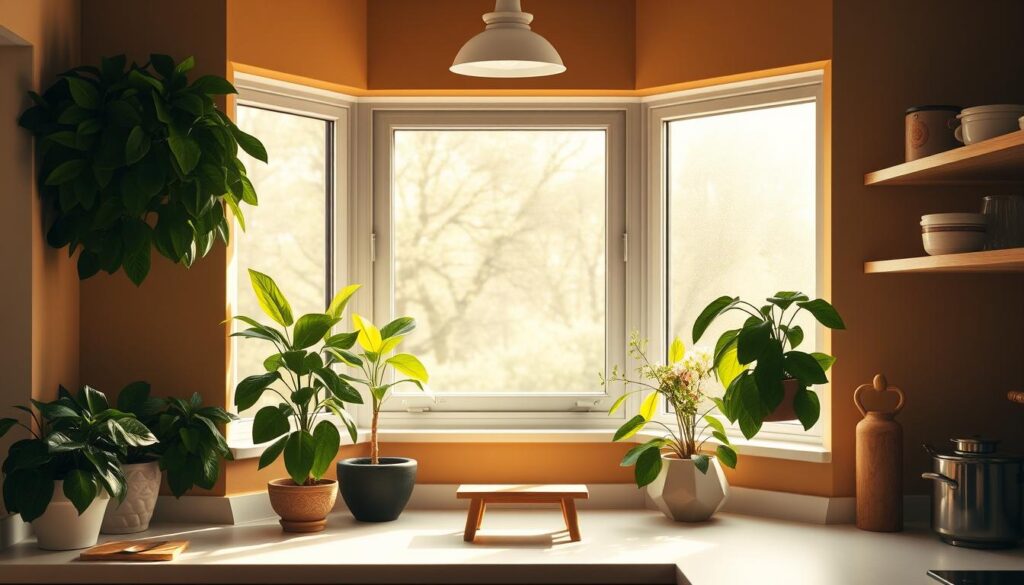
Creating a Tea or Meditation Corner
Designate a 3’x3′ nook with tatami mats or a low bench. Tea corners boost satisfaction by 38%, per Journal of Environmental Psychology. Curate a toolkit with:
- Matcha set: Bamboo whisk and handcrafted chawan bowl
- Analog timer: Silences digital distractions
- Sensory herbs: Potted mint or lavender for touch/scent
Mindful Cooking Practices
Adopt the Okinawan principle “Hara Hachi Bu”—eating until 80% full. Store portioned ingredients in glass jars to sense quantities visually. For stress-free prep:
- Chop vegetables slowly, noticing textures
- Use wooden utensils to connect with natural materials
- Pause to savor aromas before serving
“When walking, walk. When eating, eat.” — Zen proverb
These small shifts make your home’s heart more nourishing. By blending ritual with functionality, every meal becomes a moment of calm.
10. Zen-Inspired Decor and Accessories
Thoughtful accents elevate your space from ordinary to serene. Every item—from dishware to herbs—should reflect simplicity and purpose. These decor choices turn daily rituals into moments of calm.

Simple Ceramic Dishware and Wooden Bowls
Hasami porcelain resists chipping 3x better than standard stoneware. Its matte finish complements neutral tones, while East Fork’s muted glazes add subtle variation. Compare options:
- Ceramic: Non-porous, dishwasher-safe (ideal for daily use)
- Stoneware: Heavier, retains heat longer (perfect for serving)
- Wood: Lightweight, adds organic texture (best for salads)
Japanese designer Akira Minagawa’s tableware blends function with artistry. Handcrafted materials like walnut or ash age beautifully, deepening their character over time.
Potted Plants and Fresh Herbs
Snake plants remove 87% of airborne toxins, per NASA studies. A nature-inspired touch, kokedama (moss ball) herb gardens thrive in indirect light. Try these low-maintenance picks:
- Basil or mint for cooking and fragrance
- Air plants (Tillandsia) for zero-soil elegance
- Succulents in handmade terracotta pots
“A kitchen garden is the simplest way to nourish both body and soul.” — Deborah Madison
Complete the look with 100% hemp tea towels. Their durability and soft texture align perfectly with zen principles. Every detail, from wood utensils to woven baskets, should feel intentional.
11. Streamlined Appliances for Seamless Design
Modern cooking thrives when tools blend invisibly into their surroundings. Integrated appliances boost home value by 4.6% while maintaining clean lines. The best models disappear behind cabinetry panels until needed.

Built-In and Panel-Ready Solutions
Miele’s flush installation ranges sit perfectly even with countertops. Fisher & Paykel’s drawer dishwashers save space while offering full-size capacity. Compare installation approaches:
| Type | Cost Premium | Best For |
|---|---|---|
| Panel-ready | 15-20% | Custom cabinet matching |
| Built-in | 25-30% | Ultra-slim profiles |
Innovative Ventilation Systems
Bora’s downdraft cooktops achieve 650 CFM without overhead hoods. Best hoods hide ducts completely in ceiling cavities. Key design advantages:
- Low-profile: 4″ tall linear vents (vs. 12″ traditional)
- Quiet operation: 45 dB at max setting
- Smart sensors: Auto-adjust based on steam detection
“We design appliances to be silent partners—present only when you need them.” — Marc Newson, appliance designer
These solutions prove functionality doesn’t require visual clutter. From induction cooktops to column refrigerators, every element works harmoniously in the background.
12. Designing for Flow and Movement
Japanese architecture teaches us how empty space defines function. The concept of ma—meaningful negative space—creates rhythm between elements. Applied to cooking areas, this philosophy transforms chopping and stirring into graceful motions.
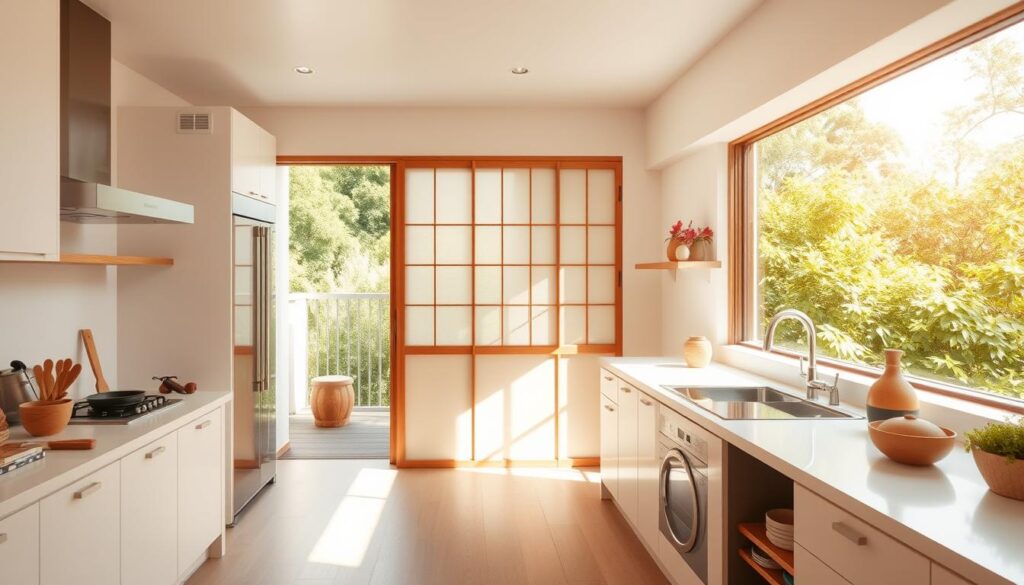
Ergonomic Clearances and Work Zones
42″ between counters isn’t arbitrary—it’s science. This clearance allows two people to pass comfortably while maintaining the work triangle. For islands, increase to 48″ if incorporating seating.
Key measurements for smooth design:
- 15″ clearance above appliances for ventilation
- 18″ landing space beside ovens
- 24″ prep zones between sink and cooktop
Sliding Door Systems Compared
PaperShade’s custom shoji screens diffuse 83% of light while saving 14″ versus swinging doors. Their rice paper panels filter UV rays, protecting surfaces from fading.
| System | Space Savings | Light Diffusion |
|---|---|---|
| Shoji screens | 14″ clearance | 83% |
| Pocket doors | Full wall width | 70% |
| Barn doors | 6″ projection | 45% |
Häfele’s silent glide tracks operate with just 1.5lbs of force. Their soft-close mechanism aligns with zen principles—no slamming, only quiet movement.
“We design tracks to disappear, letting the door’s motion feel weightless.” — Häfele engineering team
Caesarstone’s waterfall edges create visual continuity in open layouts. Their quartz material wraps seamlessly from counter to floor, guiding the eye along natural pathways.
For textured storage solutions that complement this aesthetic, explore woven natural fiber baskets. These add warmth without disrupting the clean lines essential for movement.
13. Personal Touches Without Clutter
Balancing personality with simplicity creates spaces that feel uniquely yours. The key lies in selective displays that spark joy without crowding surfaces. This approach maintains clean lines while allowing your character to shine through.
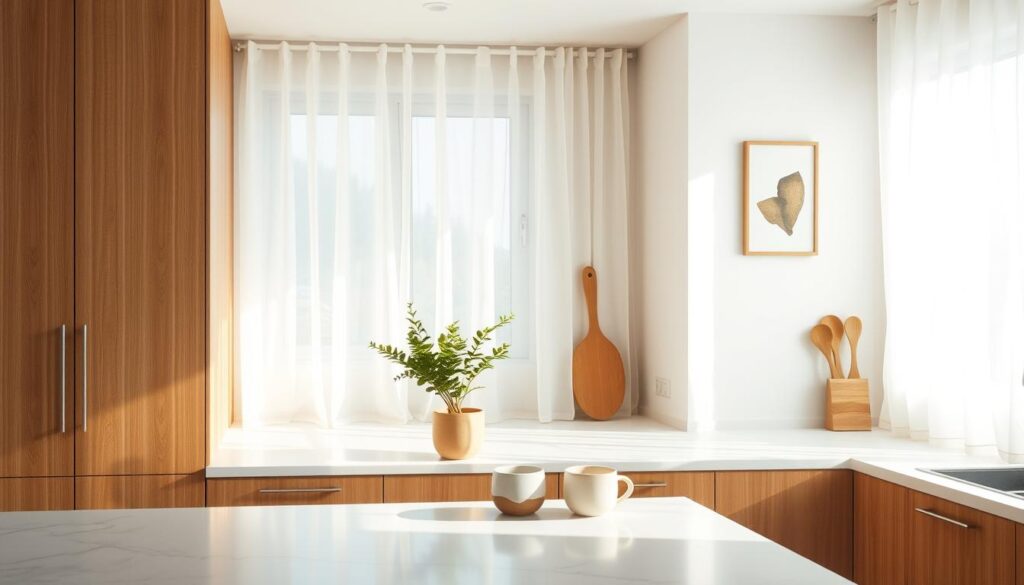
Curated Displays on Open Shelves
Studio McGee’s designers swear by the rule of thirds for shelf styling. Group items in odd numbers—three ceramic canisters or five wooden spoons—for visual harmony. Their projects show how mixing heights creates rhythm:
- Tall: Vintage olive oil bottle (12″)
- Medium: Hand-thrown bowl (6″)
- Small: Copper measuring spoons (3″)
Leave 30% negative space between objects. This gives each piece room to breathe while maintaining a sense of intentional arrangement. Local artisan collaborations add one-of-a-kind charm without overwhelming the decor.
Natural Fiber Baskets and Textures
The Citizenry’s water hyacinth organizers combine form and function beautifully. Compared to raffia, these materials resist moisture 40% better while adding organic warmth.
| Material | Best For | Care |
|---|---|---|
| Seagrass | Produce storage | Wipe clean |
| Raffia | Utensil caddies | Spot clean only |
| Water hyacinth | Blanket storage | Vacuum monthly |
“Natural textures should feel collected, not cluttered—like treasures gathered over time.” — Shea McGee
For hidden storage solutions, try woven lidded bins under islands. Their breathable construction naturally inhibits mold while keeping everyday essentials within easy reach.
14. Conclusion: Crafting Your Zen Kitchen Sanctuary
Creating a peaceful cooking space starts with intention and thoughtful choices. By focusing on simplicity, natural elements, and smart storage, you transform the heart of your home into a calming retreat.
Begin with small changes: clear one countertop, add a plant, or upgrade lighting. Over 3-6 months, these steps create the perfect balance of function and serenity. Track progress in a journal to celebrate each improvement.
For inspiration, explore Marie Kondo’s works on joyful spaces or Axel Vervoordt’s natural design philosophy. Remember—every meal prepared here can create peaceful moments.
Your zen kitchen sanctuary awaits, ready to turn daily cooking into daily renewal.

